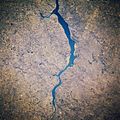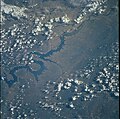Top Qs
Timeline
Chat
Perspective
List of reservoirs by surface area
From Wikipedia, the free encyclopedia
Remove ads
Below are the reservoirs (artificial lakes) in the world with a surface area exceeding 500 km2 (190 sq mi). Reservoirs can be formed conventionally, by damming the outlet of a canyon or valley to form a lake; the largest of this type is Ghana's Lake Volta, with a water surface of 8,500 km2 (3,300 sq mi). Reservoirs can also be formed by damming the outlets of natural lakes to regulate water levels, such as ones at Uganda's Owen Falls Dam (Lake Victoria) and Russia's Irkutsk Dam (Lake Baikal); they are included here and indicated with a light blue cell background.
Large reservoir area does not necessarily coincide with large volume, as reservoirs with a large area tend to be shallow, such as at Suriname's 1,560 km2 (600 sq mi) Brokopondo Reservoir, with an average depth of just 13 m (43 ft). In comparison, Canada's Kinbasket Lake, with an average depth of 58 m (190 ft), has a volume 25 percent greater – but with a surface area of just 430 km2 (170 sq mi), does not meet the cutoff for inclusion in this list.
Remove ads
List
Remove ads
See also
Notes
- Owen Falls Dam raised the level of Lake Victoria
- Irkutsk Dam and Reservoir raised the level of Lake Baikal
- Jenpeg Dam and a series of dikes and diversion channels are operated by Manitoba Hydro to maintain Lake Winnipeg as a storage reservoir for hydroelectricity generation.
- Reindeer Lake raised slightly and outflow regulated by Whitesand Dam
- Bukhtarma Dam raised the level of Lake Zaysan
References
Wikiwand - on
Seamless Wikipedia browsing. On steroids.
Remove ads
































































